Content for TS 38.413 Word version: 18.2.0
1…
4…
8…
8.2…
8.2.3…
8.3…
8.3.4…
8.4…
8.4.3…
8.5…
8.7…
8.8…
8.10…
8.12…
8.17…
9…
9.2…
9.2.2…
9.2.3…
9.2.4…
9.2.6…
9.2.7…
9.2.9…
9.2.11…
9.2.16…
9.2.17…
9.3…
9.3.1.21…
9.3.1.41…
9.3.1.61…
9.3.1.81…
9.3.1.101…
9.3.1.121…
9.3.1.141…
9.3.1.161…
9.3.1.181…
9.3.1.205…
9.3.1.222…
9.3.1.245…
9.3.2…
9.3.3…
9.3.3.21…
9.3.3.42…
9.3.4…
9.3.4.10…
9.3.5…
9.4…
9.4.4
9.4.5
9.4.6…
9.5…
10…
8.3.4 UE Context Modification
8.3.5 RRC Inactive Transition Report
8.3.6 Connection Establishment Indication
8.3.7 AMF CP Relocation Indication
8.3.8 RAN CP Relocation Indication
8.3.9 Retrieve UE Information
8.3.10 UE Information Transfer
8.3.11 UE Context Suspend
8.3.12 UE Context Resume
8.3.13 MT Communication Handling
8.3.14 RAN Paging Request
...
...
8.3.4 UE Context Modification p. 51
8.3.4.1 General p. 51
The purpose of the UE Context Modification procedure is to partly modify the established UE context. The procedure uses UE-associated signalling.
8.3.4.2 Successful Operation p. 51
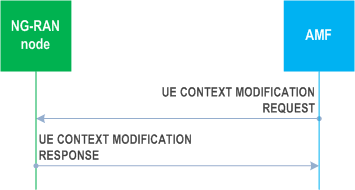
Upon receipt of the UE CONTEXT MODIFICATION REQUEST message the NG-RAN node shall
- if supported, store the received IAB Authorization information in the UE context and use it as specified in TS 38.401.
- if supported, store the received Mobile IAB Authorization information in the UE context. If the Mobile IAB Authorized IE is set to "not authorized" for a mobile IAB-MT, the NG-RAN node shall, if supported, initiate actions to ensure that the mobile IAB-node will not serve any UE(s).
- replace the previously provided UE Aggregate Maximum Bit Rate by the received UE Aggregate Maximum Bit Rate in the UE context;
- use the received UE Aggregate Maximum Bit Rate for all Non-GBR QoS flows for the concerned UE as specified in TS 23.501.
- replace the previously provided NR UE Sidelink Aggregate Maximum Bit Rate, if available in the UE context, with the received value;
- use the received value for the concerned UE's sidelink communication in network scheduled mode for NR V2X services.
- replace the previously provided LTE UE Sidelink Aggregate Maximum Bit Rate, if available in the UE context, with the received value;
- use the received value for the concerned UE's sidelink communication in network scheduled mode for LTE V2X services.
- replace the previously provided NR A2X UE PC5 Aggregate Maximum Bit Rate, if available in the UE context, with the received value;
- use the received value for the concerned UE's sidelink communication in network scheduled mode for NR A2X services.
- replace the previously provided LTE A2X UE PC5 Aggregate Maximum Bit Rate, if available in the UE context, with the received value;
- use the received value for the concerned UE's sidelink communication in network scheduled mode for LTE A2X services.
- store and replace the previously provided UE Slice Maximum Bit Rate List, if any, by the received UE Slice Maximum Bit Rate List in the UE context;
- use the received UE Slice Maximum Bit Rate List for each S-NSSAI for the concerned UE as specified in TS 23.501.
- replace the previously provided 5G ProSe UE PC5 Aggregate Maximum Bit Rate, if available in the UE context, with the received value;
- use the received value for the concerned UE's sidelink communication in network scheduled mode for 5G ProSe services.
If the RRC Inactive Transition Report Request IE is included in the UE CONTEXT MODIFICATION REQUEST message and set to "single RRC connected state report", the NG-RAN node shall, if supported and if the UE is in RRC_INACTIVE state, send one subsequent RRC INACTIVE TRANSITION REPORT message to the AMF when the RRC state transitions to RRC_CONNECTED state.
If the RRC Inactive Transition Report Request IE is included in the UE CONTEXT MODIFICATION REQUEST message and set to "subsequent state transition report", the NG-RAN node shall, if supported, send the RRC INACTIVE TRANSITION REPORT message to the AMF to report the RRC state of the UE when the UE enters or leaves RRC_INACTIVE state.
8.3.4.3 Unsuccessful Operation p. 55
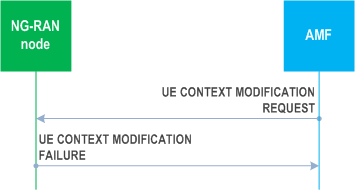
In case the UE context update cannot be performed successfully, the NG-RAN node shall respond with the UE CONTEXT MODIFICATION FAILURE message to the AMF with an appropriate cause value in the Cause IE.
If the New AMF UE NGAP ID IE is included in the UE CONTEXT MODIFICATION REQUEST message, the NG-RAN node may use the received New AMF UE NGAP ID IE or Old AMF UE NGAP ID IE in the UE CONTEXT MODIFICATION FAILURE message.
8.3.4.4 Abnormal Conditions p. 55
If the UE CONTEXT MODIFICATION REQUEST message including the New AMF UE NGAP ID IE is received after the NG-RAN node has initiated another class 1 NGAP EP, the NG-RAN node shall be prepared to receive the response message containing an AMF UE NGAP ID with the value received in the New AMF UE NGAP ID IE.
8.3.5 RRC Inactive Transition Report p. 55
8.3.5.1 General p. 55
The purpose of the RRC Inactive Transition Report procedure is to notify the AMF when the UE enters or leaves RRC_INACTIVE state. The procedure uses UE-associated signalling.
8.3.5.2 Successful Operation p. 55
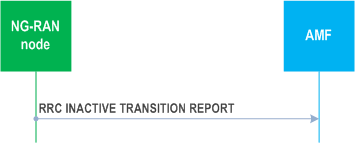
The NG-RAN node initiates the procedure by sending an RRC INACTIVE TRANSITION REPORT message to the AMF. Upon reception of the RRC INACTIVE TRANSITION REPORT message, the AMF shall take appropriate actions based on the information indicated by the RRC State IE.
8.3.5.3 Abnormal Conditions p. 56
Void.
8.3.6 Connection Establishment Indication |R16| p. 56
8.3.6.1 General p. 56
The purpose of the Connection Establishment Indication procedure is to enable the AMF to complete the establishment of the UE-associated logical NG-connection. The procedure uses UE-associated signalling. This procedure applies only if the NG-RAN node is an ng-eNB.
8.3.6.2 Successful Operation p. 56
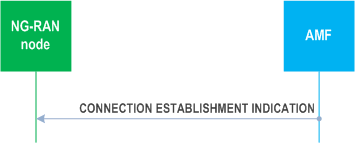
The AMF initiates the procedure by sending a CONNECTION ESTABLISHMENT INDICATION message to the NG-RAN node.
If the UE-associated logical NG-connection is not established, the AMF shall allocate a unique AMF UE NGAP ID to be used for the UE and include it in the CONNECTION ESTABLISHMENT INDICATION message.
If the UE Radio Capability IE is included in the CONNECTION ESTABLISHMENT INDICATION message, the NG-RAN node shall store this information in the UE context, and use it as defined in TS 38.300.
If the End Indication IE is included in the CONNECTION ESTABLISHMENT INDICATION message and set to "no further data", the NG-RAN node shall consider that there are no further NAS PDUs to be transmitted for this UE.
If the S-NSSAI IE is contained in the CONNECTION ESTABLISHMENT INDICATION message, the NG-RAN node shall store this information in the UE context, and use it as specified in TS 23.501.
If the Allowed NSSAI IE is contained in the CONNECTION ESTABLISHMENT INDICATION message, the NG-RAN node shall store this information in the UE context, and use it as specified in TS 23.501.
If the Partially Allowed NSSAI IE is contained in the CONNECTION ESTABLISHMENT INDICATION message, the NG-RAN node shall, if supported, deduce from it the partially allowed network slices for the UE, store and replace any previously received Partially Allowed NSSAI and use it as specified in TS 23.501.
If the Ranging and Sidelink Positioning Service Information IE is contained in the HANDOVER REQUEST message, the NG-RAN node shall, if supported, take it into account for the Ranging and Sidelink Positioning service.
If the UE Differentiation Information IE is included in the CONNECTION ESTABLISHMENT INDICATION message, the NG-RAN node shall, if supported, store this information in the UE context for further use according to TS 23.501.
If the DL CP Security Information IE is included in the CONNECTION ESTABLISHMENT INDICATION message, the NG-RAN node shall forward this information to the UE as described in TS 36.300.
If the NB-IoT UE Priority IE is contained in the CONNECTION ESTABLISHMENT INDICATION message, the NG-RAN node shall, if supported, store this information in the UE context, and use it as specified in TS 23.501.
If the Enhanced Coverage Restriction IE is included in the CONNECTION ESTABLISHMENT INDICATION message, the NG-RAN node shall, if supported, store this information in the UE context and use it as defined in TS 23.501.
If the CE-mode-B Restricted IE is included in the CONNECTION ESTABLISHMENT INDICATION message and the Enhanced Coverage Restriction IE is not set to "restricted" and the Enhanced Coverage Restricted information stored in the UE context is not set to "restricted", the NG-RAN node shall, if supported, store this information in the UE context and use it as defined in TS 23.501.
If the UE Radio Capability ID IE is contained in the CONNECTION ESTABLISHMENT INDICATION message, the NG-RAN node shall, if supported, use it as specified in TS 23.501 and TS 23.502.
If the Masked IMEISV IE is contained in the CONNECTION ESTABLISHMENT INDICATION message, the NG-RAN node shall, if supported, use it to determine the characteristics of the UE for subsequent handling.
If the Old AMF IE is included in the CONNECTION ESTABLISHMENT INDICATION message, the NG-RAN node shall consider that this UE-associated logical NG-connection was redirected to this AMF from another AMF identified by the Old AMF IE.
8.3.6.3 Abnormal Conditions p. 57
If the Partially Allowed NSSAI IE is received in the CONNECTION ESTABLISHMENT INDICATION message and the total number of S-NSSAIs included in the Allowed NSSAI and Partially Allowed NSSAI exceeds eight, the NG-RAN node shall consider the procedure as failed.
If any of the S-NSSAI which is present in the Partially Allowed NSSAI IE is also present in the Allowed NSSAI IE, the NG-RAN node shall consider the procedure as failed.
8.3.7 AMF CP Relocation Indication |R16| p. 57
8.3.7.1 General p. 57
The purpose of the AMF CP Relocation Indication procedure is to inform the NG-RAN node that the UE's connection is to be relocated to another NG-RAN node as described in TS 38.300, for a UE using Control Plane CIoT 5GS Optimisation. This procedure applies only if the NG-RAN node is an ng-eNB.
The procedure uses UE-associated signalling.
8.3.7.2 Successful Operation p. 57
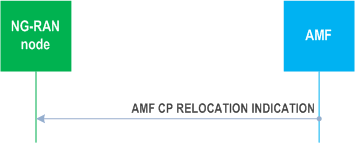
The AMF initiates the procedure by sending an AMF CP RELOCATION INDICATION message to the NG-RAN node.
Upon reception of the AMF CP RELOCATION INDICATION message, the NG-RAN node shall terminate the delivery of NAS messages that have been received from the AMF.
If the S-NSSAI IE is contained in the AMF CP RELOCATION INDICATION message, the NG-RAN node shall store this information in the UE context, and use it as specified in TS 23.501.
If the Allowed NSSAI IE is contained in the AMF CP RELOCATION INDICATION message, the NG-RAN node shall store this information in the UE context, and use it as specified in TS 23.501.
If the Partially Allowed NSSAI IE is contained in the AMF CP RELOCATION INDICATION message, the NG-RAN node shall, if supported, deduce from it the partially allowed network slices for the UE, store and replace any previously received Partially Allowed NSSAI and use it as specified in TS 23.501.
Interactions with NAS Non Delivery Indication procedure:
On reception of the AMF CP RELOCATION INDICATION message, the NG-RAN node may initiate NAS Non Delivery Indication procedure(s) to report the non-delivery of any NAS PDUs previously received from the AMF.
8.3.7.3 Abnormal Conditions p. 58
If the Partially Allowed NSSAI IE is received in the AMF CP RELOCATION INDICATION message and the total number of S-NSSAIs included in the Allowed NSSAI and Partially Allowed NSSAI exceeds eight, the NG-RAN node shall consider the procedure as failed.
If any of the S-NSSAI which is present in the Partially Allowed NSSAI IE is also present in the Allowed NSSAI IE, the NG-RAN node shall consider the procedure as failed.
8.3.8 RAN CP Relocation Indication |R16| p. 58
8.3.8.1 General p. 58
The purpose of the RAN CP Relocation Indication procedure is to request the AMF to authenticate the UE's re-establishment request, and trigger the establishment of the respective UE-associated logical NG-connection, for a NB-IoT UE using Control Plane CIoT 5GS Optimisation. This procedure applies only if the NG-RAN node is an ng-eNB.
The procedure uses UE-associated signalling.
8.3.8.2 Successful Operation p. 58
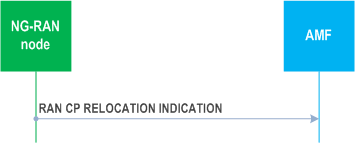
The NG-RAN node initiates the procedure by sending a RAN CP RELOCATION INDICATION message to the AMF.
The NG-RAN node shall allocate a unique RAN UE NGAP ID to be used for the UE and the NG-RAN node shall include this identity in the RAN CP RELOCATION INDICATION message.
Upon receiving the RAN CP RELOCATION INDICATION message, the AMF shall authenticate the request using the NAS-level security information received in the UL CP Security Information IE and if the authentication is successful initiate the Connection Establishment Indication procedure including NAS-level security information in the DL CP Security Information IE.
In case the AMF cannot authenticate the UE's request, the CONNECTION ESTABLISHMENT INDICATION message does not contain security information, and the NG-RAN node shall fail the RRC Re-establishment.
In case of authentication failure, the NG-RAN node and the AMF should locally release the allocated NG resources, if any.
Interactions with the AMF CP Relocation and UE Context Release procedures:
In case of successful UE authentication, the AMF initiates the UE Context Release procedure to release the UE's NG-connection in the old NG-RAN node. The AMF may initiate the AMF CP Relocation procedure before the release procedure in order to trigger the old NG-RAN node to return non-delivered NAS PDUs to the AMF.
8.3.8.3 Abnormal Conditions p. 59
Void.
8.3.9 Retrieve UE Information |R16| p. 59
8.3.9.1 General p. 59
The purpose of the Retrieve UE Information procedure is for the NG-RAN node to request the UE information including NB-IoT UE Priority and UE Radio Capability from the AMF, for a NB-IoT UE using Control Plane CIoT 5GS Optimisation. The procedure uses non UE-associated signalling. This procedure applies only if the NG-RAN node is an ng-eNB.
8.3.9.2 Successful Operation p. 59
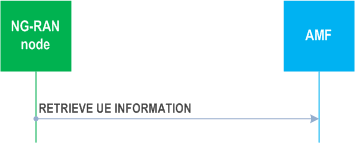
The NG-RAN node initiates the procedure by sending the RETRIEVE UE INFORMATION message to the AMF.
8.3.9.3 Abnormal Conditions p. 59
Void.
8.3.10 UE Information Transfer |R16| p. 59
8.3.10.1 General p. 59
The purpose of the UE Information Transfer procedure is for the AMF to send the UE information including NB-IoT UE Priority and UE Radio Capability to the NG-RAN node, for a NB-IoT UE using Control Plane CIoT 5GS Optimisation. The procedure uses non UE-associated signalling. This procedure applies only if the NG-RAN node is an ng-eNB.
8.3.10.2 Successful Operation p. 59
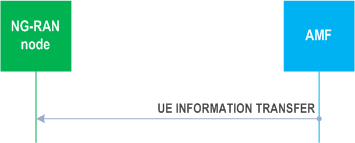
The AMF initiates the procedure by sending the UE INFORMATION TRANSFER message to the NG-RAN node.
If the NB-IoT UE Priority IE is contained in the UE INFORMATION TRANSFER message, the NG-RAN node shall store this information in the UE context, and use it as specified in TS 23.501.
If the UE Radio Capability IE is contained in the UE INFORMATION TRANSFER message, the NG-RAN node shall store this information in the UE context, and use it as specified in TS 23.501.
If the S-NSSAI IE is contained in the UE INFORMATION TRANSFER message, the NG-RAN node shall store this information in the UE context, and use it as specified in TS 23.501.
If the Allowed NSSAI IE is contained in the UE INFORMATION TRANSFER message, the NG-RAN node shall store this information in the UE context, and use it as specified in TS 23.501.
If the Partially Allowed NSSAI IE is contained in the UE INFORMATION TRANSFER message, the NG-RAN node shall, if supported, deduce from it the partially allowed network slices for the UE, store and replace any previously received Partially Allowed NSSAI and use it as specified in TS 23.501.
If the UE Differentiation Information IE is included in the UE INFORMATION TRANSFER message, the NG-RAN node shall, if supported, store this information in the UE context for further use according to TS 23.501.
If the Masked IMEISV IE is contained in the UE INFORMATION TRANSFER message, the NG-RAN node shall, if supported, use it to determine the characteristics of the UE for subsequent handling.
8.3.10.3 Abnormal Conditions p. 60
If the Partially Allowed NSSAI IE is received in the UE INFORMATION TRANSFER message and the total number of S-NSSAIs included in the Allowed NSSAI and Partially Allowed NSSAI exceeds eight, the NG-RAN node shall consider the procedure as failed.
If any of the S-NSSAI which is present in the Partially Allowed NSSAI IE is also present in the Allowed NSSAI IE, the NG-RAN node shall consider the procedure as failed.
8.3.11 UE Context Suspend |R16| p. 60
8.3.11.1 General p. 60
The purpose of the UE Context Suspend procedure is to suspend the UE-associated logical NG-connection and the NG-U transport bearer with the 5GC while keeping the UE context in the NG-RAN node. The procedure uses UE-associated signalling.
In this version of the specification, this procedure applies only if the NG-RAN node is an ng-eNB.
8.3.11.2 Successful Operation p. 61
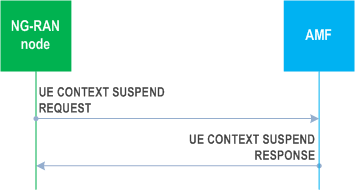
The NG-RAN node initiates the procedure by sending the UE CONTEXT SUSPEND REQUEST message to the AMF.
Upon receipt of the UE CONTEXT SUSPEND REQUEST message the AMF shall act as defined in TS 23.502.
Upon receipt of the UE CONTEXT SUSPEND RESPONSE message the NG-RAN node shall suspend the UE context, the UE-associated logical NG-connection and the related PDU session contexts and send the UE to RRC_IDLE.
If the Information on Recommended Cells and RAN Nodes for Paging IE is included in the UE CONTEXT SUSPEND REQUEST message, the AMF shall, if supported, store it and may use it for subsequent paging.
If the Paging Assistance Data for CE Capable UE IE is included in the UE CONTEXT SUSPEND REQUEST message, the AMF shall, if supported, store it and use it for subsequent paging, as specified in TS 23.502.
If the Security Context IE is included in the UE CONTEXT SUSPEND RESPONSE message, the NG-RAN node shall store the received Security Context IE in the UE context and remove any existing unused stored {NH, NCC} as specified in TS 33.501.
If the Suspend Indicator IE is included in the UE CONTEXT SUSPEND REQUEST message, the SMF shall, if supported, consider the associated PDU session as suspended.
8.3.11.3 Unsuccessful Operation p. 61
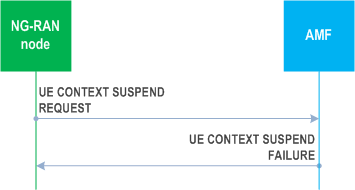
If the AMF decides to not suspend the connection e.g. due to pending downlink data to be sent, it shall send the UE CONTEXT SUSPEND FAILURE message to the NG-RAN node.
8.3.11.4 Abnormal Conditions p. 61
Void.
8.3.12 UE Context Resume |R16| p. 62
8.3.12.1 General p. 62
The purpose of the UE Context Resume procedure is to resume the UE context, the suspended UE-associated logical NG-connection and the related NG-U transport bearer in the 5GC for this UE. The procedure uses UE-associated signalling.
In this version of the specification, this procedure applies only if the NG-RAN node is an ng-eNB.
8.3.12.2 Successful Operation p. 62
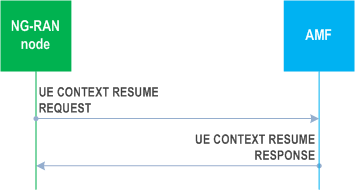
The NG-RAN node initiates the procedure by sending the UE CONTEXT RESUME REQUEST message to the AMF. If the NG-RAN node is not able to admit any suspended PDU sessions, the NG-RAN node shall indicate this in the PDU Session Resource Failed to Resume List IE. If the NG-RAN node is not able to admit certain QoS flows for a PDU session, the NG-RAN node shall indicate this in the QoS Flow Failed to Resume List IE included in the UE Context Resume Request Transfer IE for that PDU session.
Upon receipt of the UE CONTEXT RESUME REQUEST message the AMF shall act as defined in TS 23.502 and respond with the UE CONTEXT RESUME RESPONSE message. If the AMF is not able to admit any suspended PDU sessions, the AMF shall indicate this in the PDU Session Resource Failed to Resume List IE. If the SMF is not able to admit certain QoS flows for a PDU session, the SMF shall indicate this in the QoS Flow Failed to Resume List IE included in the UE Context Resume Response Transfer IE for that PDU session.
The NG-RAN node shall release resources for each PDU session or QoS flow failed to resume and shall assume that the 5GC has released respective resources as well.
If the Security Context IE is included in the UE CONTEXT RESUME RESPONSE message, the NG-RAN node shall store the received Security Context IE in the UE context and the NG-RAN node shall use it for the next suspend/resume or Xn handover or Intra NG-RAN node handovers as specified in TS 33.501.
If the Suspend Request Indication IE is included in the UE CONTEXT RESUME REQUEST message, the AMF shall, if supported, consider that the NG-RAN node is requesting immediate transition to RRC IDLE with Suspend as specified in TS 23.502. If the Suspend Response Indication IE is included in the UE CONTEXT RESUME RESPONSE message, the NG-RAN node shall suspend the UE context, the UE-associated logical NG-connection and the related PDU session contexts and send the UE to RRC_IDLE.
If the Information on Recommended Cells and RAN Nodes for Paging IE is included in the UE CONTEXT RESUME REQUEST message, the AMF shall, if supported, store it and may use it for subsequent paging.
If the Paging Assistance Data for CE Capable UE IE is included in the UE CONTEXT RESUME REQUEST message, the AMF shall, if supported, store it and use it for subsequent paging, as specified in TS 23.502.
If the Extended Connected Time IE is included in the UE CONTEXT RESUME RESPONSE message, the NG-RAN node shall, if supported, use it as described in TS 23.501.
8.3.12.3 Unsuccessful Operation p. 63
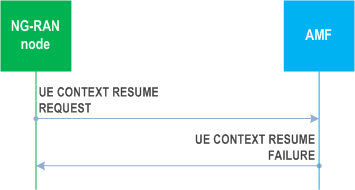
If the AMF is not able to resume a single PDU session, it releases the UE-associated logical NG-connection by sending the UE CONTEXT RESUME FAILURE message to the NG-RAN node. Upon reception of the UE CONTEXT RESUME FAILURE message the NG-RAN node shall release the RRC connection as specified in TS 36.331 and release all related signalling and user data transport resources.
8.3.12.4 Abnormal Conditions |R18| p. 63
Void.
8.3.13 MT Communication Handling |R18| p. 63
8.3.13.1 General p. 63
The purpose of the MT Communication Handling procedure is to request the AMF to activate or deactivate the CN based MT communication handling for a UE in RRC_INACTIVE state with eDRX beyond 10.24 seconds as specified in TS 23.501. The procedure uses UE-associated signalling.
8.3.13.2 Successful Operation p. 63
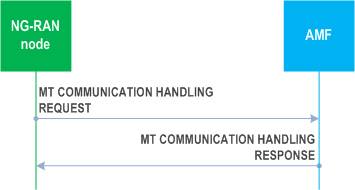
The NG-RAN node initiates the procedure by sending the MT COMMUNICATION HANDLING REQUEST message to the AMF.
If the 5GC Action IE included in the MT COMMUNICATION HANDLING REQUEST message is set to "HLCom Activate", the AMF shall activate MT communication handling for the PDU session(s) indicated in the PDU Session Resource List IE as specified in TS 23.501 and take into account the NR Paging Long eDRX Information for RRC INACTIVE IE when applying MT communication handling as specified in TS 38.304 and TS 23.502.
If the 5GC Action IE included in the MT COMMUNICATION HANDLING REQUEST message is set to "HLCom Deactivate", the AMF shall deactivate MT communication handling for the PDU session(s) indicated in the PDU Session Resource List IE as specified in TS 23.501.
8.3.13.3 Unsuccessful Operation p. 64
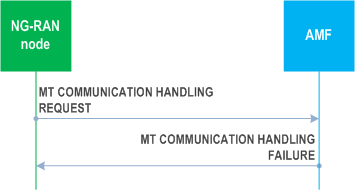
If the AMF is not able to activate CN based MT communication handling for the UE configured with eDRX cycle value longer than 10.24 seconds in RRC_INACTIVE state, it shall send a MT COMMUNICATION HANDLING FAILURE message to the NG-RAN node.
8.3.13.4 Abnormal Conditions p. 64
Void.
8.3.14 RAN Paging Request |R18| p. 64
8.3.14.1 General p. 64
This procedure is initiated by the AMF to indicate that there is DL data buffered in 5GC or DL signalling arrives for the UE. The procedure uses UE-associated signalling.
8.3.14.2 Successful Operation p. 64
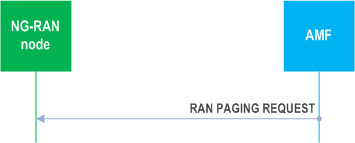
The AMF initiates the RAN Paging Request procedure by sending the RAN PAGING REQUEST message to the NG-RAN node.
Upon reception of the RAN PAGING REQUEST message, the NG-RAN node shall perform RAN Paging for the UE in RRC_INACTIVE state.
If the Paging Policy Differentiation IE is included in the RAN PAGING REQUEST message, the NG-RAN node shall, if supported, take it into account when performing RAN Paging for the UE in RRC_INACTIVE state.
If the DL Signalling IE is included in the RAN PAGING REQUEST message, the NG-RAN node shall, if supported, take it into account when performing RAN Paging for the UE in RRC_INACTIVE state.
8.3.14.3 Abnormal Conditions p. 64
Void.